Every homeowner encounters the occasional leaky faucet, squeaky door, or cracked wall that demands attention. Hiring professionals for every small issue can quickly become expensive, which is why learning a few DIY home repair tips can save both money and time. Understanding basic home maintenance empowers you to handle minor repairs confidently while keeping your home in top condition. Whether you’re a new homeowner or a seasoned do-it-yourselfer, these simple fixes every homeowner should know will help you maintain your home like a pro.
1. Fixing Leaky Faucets to Save Water and Money
A dripping faucet may seem minor, but it can waste gallons of water daily and inflate your water bill. The good news is that fixing it is often as simple as replacing a worn-out washer or O-ring. Start by turning off the water supply under the sink, then disassemble the faucet handle using a wrench or screwdriver. Replace any damaged parts and reassemble the faucet. In most cases, this quick fix takes less than 30 minutes and requires minimal tools. Regularly checking for leaks can help prevent costly plumbing issues later.
2. Patching Wall Holes and Cracks Easily
Small wall dents and nail holes can make your walls look worn and neglected. Fortunately, patching them up is an easy DIY home repair project. All you need is some spackling paste, a putty knife, and sandpaper. Apply the spackle over the hole, smooth it out, and let it dry. Once it’s dry, lightly sand the area until it’s flush with the wall and paint over it. For larger holes, you can use a patch kit or mesh tape before applying spackle. This quick fix instantly improves your home’s interior appearance.
3. Quieting Squeaky Doors and Hinges
Squeaky doors can be irritating, but the fix is simple and effective. Start by applying a lubricant such as WD-40 or even household oil to the hinge pins. Move the door back and forth to distribute the lubricant evenly. If the noise persists, remove the hinge pins, clean them with steel wool, and apply a fresh coat of lubricant before reinstalling. Regular maintenance keeps doors opening smoothly and prevents metal parts from wearing down over time.
4. Unclogging Drains Without Harsh Chemicals
Clogged drains are common household nuisances, but harsh chemical cleaners can damage pipes. Instead, try a natural and eco-friendly solution: pour half a cup of baking soda down the drain followed by half a cup of vinegar. Let it fizz for 10–15 minutes, then flush with boiling water. For tougher clogs, use a plunger or a drain snake. Performing this cleaning once a month helps maintain healthy, odor-free plumbing throughout your home.
5. Replacing Broken Tiles for a Fresh Look
Cracked tiles in your bathroom or kitchen can ruin the look of your space. Replacing them is easier than you might think. Begin by removing the damaged tile using a hammer and chisel, then clean the surface beneath. Apply a thin layer of tile adhesive and place the new tile, ensuring it aligns with the surrounding ones. Once the adhesive dries, apply grout around the edges and wipe away the excess. This simple fix restores your flooring or wall to a flawless finish without the need for professional help.
6. Repairing Loose Cabinet Doors
Loose cabinet doors are often caused by worn or stripped screws. To fix them, remove the screw and insert a wooden toothpick or small dowel coated in wood glue into the hole. Let it dry, then reinsert the screw. This tightens the hinge securely and prevents the door from sagging. Regularly checking and tightening cabinet hardware ensures that your kitchen and bathroom storage remain sturdy and functional.
7. Sealing Windows and Doors for Energy Efficiency
If you feel drafts coming from your windows or doors, it’s time to reseal them. Use weatherstripping tape or silicone caulk to seal gaps and prevent warm or cool air from escaping. This simple fix not only improves comfort but also lowers your energy bills. It’s one of the easiest and most cost-effective DIY home repair tips that enhances your home’s insulation and keeps your heating and cooling system working efficiently year-round.
8. Fixing Running Toilets to Save Water
A constantly running toilet can waste gallons of water daily. The most common culprit is a faulty flapper or fill valve inside the tank. Open the lid and inspect these components. If the flapper doesn’t seal properly, replace it—it’s an inexpensive part available at any hardware store. Similarly, adjust or replace the fill valve if water continues to flow. With these quick repairs, you’ll restore your toilet’s efficiency and reduce unnecessary water waste.
9. Repairing Cracked Grout for a Cleaner Bathroom
Cracked grout allows water to seep behind tiles, leading to mold or structural damage. To repair it, use a grout saw to remove the damaged material, then apply fresh grout using a rubber float. Wipe off any excess before it dries. Once it’s set, seal the grout to prevent future moisture damage. This easy project not only keeps your bathroom looking clean but also protects it from hidden water issues.
10. Touching Up Paint for a Polished Look
Over time, walls and trim can develop scuffs and stains. Keeping a small can of your wall paint for touch-ups can make your home look freshly painted all year. Lightly sand the area, clean it with a damp cloth, and apply a small amount of paint with a brush or roller. Blending the edges helps maintain a seamless appearance. This small effort gives your home an instant refresh without the need for a full repainting job.
11. Replacing Light Fixtures and Switches Safely
Upgrading old light fixtures can modernize your home instantly. Before beginning, always turn off the power from the circuit breaker. Remove the old fixture, connect the new wires following the color codes (black to black, white to white, and green or bare for ground), and install the new fixture securely. If you’re not comfortable working with electricity, consult a professional. However, most simple swaps can be completed safely with careful preparation.
12. Maintaining Your Home for Long-Term Value
Routine maintenance ensures that small problems don’t turn into expensive repairs. Create a home maintenance checklist to track seasonal tasks such as gutter cleaning, HVAC filter changes, and roof inspections. Regular upkeep preserves your property’s value and prevents unexpected issues. Embracing DIY home repair tips empowers homeowners to take control of their living spaces and enjoy a sense of accomplishment.
Conclusion
Homeownership comes with its share of maintenance challenges, but most issues can be resolved with basic tools, patience, and a little knowledge. From fixing leaks to sealing windows, these DIY home repair tips: simple fixes every homeowner should know provide practical, cost-effective solutions that save money and keep your home in excellent shape. With consistent effort, you can maintain your property’s beauty, comfort, and efficiency—without always needing professional help.

